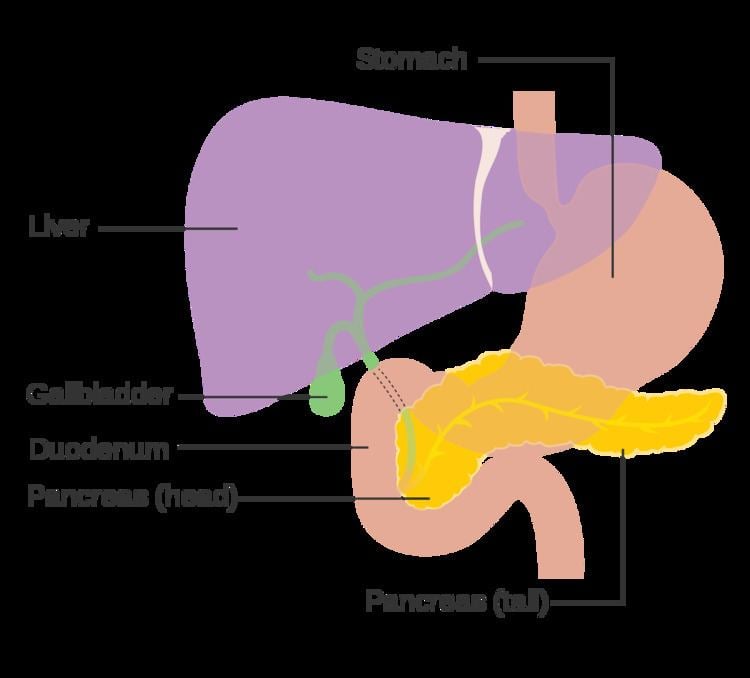eMedicine med/ | ICD-10 C25.4 | |
 | ||
Pancreatic neuroendocrine tumors (PanNETs, PETs, or PNETs), often referred to as "islet cell tumors", or "pancreatic endocrine tumors" are neuroendocrine neoplasms that arise from cells of the endocrine (hormonal) and nervous system within the pancreas.
Contents
PanNETs are a type of neuroendocrine tumor, representing about one third of gastroenteropancreatic neuroendocrine tumors (GEP-NETs). Many PanNETs are benign, while some are malignant. Aggressive PanNET tumors have traditionally been termed "islet cell carcinoma".
PanNETs are quite distinct from the usual form of pancreatic cancer, the majority of which are adenocarcinomas, which arises in the exocrine pancreas. Only 1 or 2% of clinically significant pancreas neoplasms are PanNETs.
Types
PanNETs are sometimes abbreviated as PETs or PNETs: such use should not to be confused with the primitive neuroectodermal tumor (PNET).
The majority of PanNETs are benign, while some are malignant. The World Health Organization (WHO) classification scheme places neuroendocrine tumors into three main categories, which emphasize the tumor grade rather than the anatomical origin. In practice, those tumors termed well or intermediately differentiated PanNETs in the WHO scheme are sometimes called "islet cell tumors." The high grade subtype, termed neuroendocrine cancer (NEC) in the WHO scheme, is synonymous with "islet cell carcinoma".
Signs and symptoms
Some PanNETs do not cause any symptoms, in which case they may be discovered incidentally on a CT scan performed for a different purpose. Symptoms such as abdominal or back pain or pressure, diarrhea, indigestion, or yellowing of the skin and whites of the eyes can arise from the effects of a larger PanNET tumor, either locally or at a metastasis. About 40% of PanNETS have symptoms related to excessive secretion of hormones or active polypeptides and are accordingly labeled as "functional"; the symptoms reflect the type of hormone secreted, as discussed below. Up to 60% of PanNETs are nonsecretory or nonfunctional, in which there is no secretion, or the quantity or type of products, such as pancreatic polypeptide (PPoma), chromogranin A, and neurotensin, do not cause a clinical syndrome although blood levels may be elevated. In total, 85% of PanNETs have an elevated blood marker.
Functional tumors are often classified by the hormone most strongly secreted, for example:
In these various types of functional tumors, the frequency of malignancy and the survival prognosis have been estimated dissimilarly, but a pertinent accessible summary is available.
Imaging
MEN1
Personal and family history should be evaluated for MEN1.
Staging
The 2010 WHO classification of tumors of the digestive system grades all the neuroendocrine tumors into three categories, based on their degree of cellular differentiation (from well-differentiated "NET G1" through to poorly-differentiated "NET G3"). The NCCN recommends use of the same AJCC-UICC staging system as pancreatic adenocarcinoma. Using this scheme, the stage by stage outcomes for PanNETs are dissimilar to pancreatic exocrine cancers. A different TNM system for PanNETs has been proposed by The European Neuroendocrine Tumor Society.
Treatment
In general, treatment for PanNET encompasses the same array of options as other neuroendocrine tumors, as discussed in that main article. However, there are some specific differences, which are discussed here.
In functioning PanNETs, octreotide is usually recommended prior to biopsy or surgery but is generally avoided in insulinomas to avoid profound hypoglycemia.
PanNETs in MEN1 are often multiple, and thus require different treatment and surveillance strategies.
Some PanNETs are more responsive to chemotherapy than are gastroenteric carcinoid tumors. Several agents have shown activity. In well differentiated PanNETs, chemotherapy is generally reserved for when there are no other treatment options. Combinations of several medicines have been used, such as doxorubicin with streptozocin and fluorouracil (5-FU) and capecitabine with temozolomide. Although marginally effective in well-differentiated PETs, cisplatin with etoposide has some activity in poorly differentiated neuroendocrine cancers (PDNECs), particularly if the PDNEC has an extremely high Ki-67 score of over 50%.
Several targeted therapy agents have been approved in PanNETs by the FDA based on improved progression-free survival (PFS):
Genetics
DNA mutation analysis in well-differentiated pancreatic neuroendocrine tumors identified four important findings:
